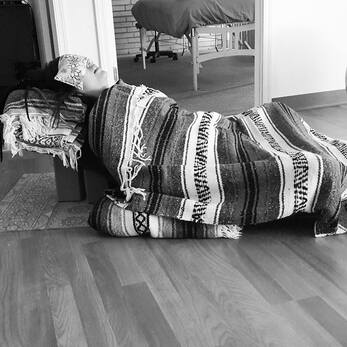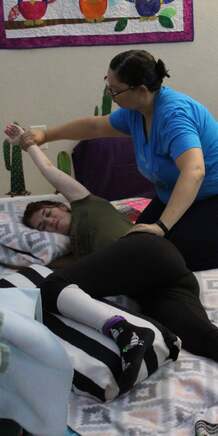
Restorative yoga can help you feel better in your body, calmer in your mind, and happier in your life. This gentle, therapeutic style of yoga uses props to hold you in poses comfortably for a longer period of time.
Restorative yoga is a deeply relaxing practice that is passive, rather than active. Blankets, pillows, and straps support the body in different shapes and gravity does all the work to gradually and gently allow the body to release tension.
Restorative yoga teaches patience, mindfulness, and compassion. When practicing, you enter a deep state of relaxation. Here you can let go of deep holding patterns in the body and find a state of rest that allows the body to heal.
You can expect to hold poses 5-25 minutes each in a Restorative Yoga class. A typical class only moves through 4-6 poses depending on if it is an hour or 90-minute class. Restorative yoga is a great complement to other types of yoga. It is recommended that you practice at least once a week, but it can be practiced every day. If you’re short on time, you can practice just one pose for 5-20 minutes.
History of Restorative Yoga. Restorative yoga poses originated in the Iyengar tradition, using props to help each student find the alignment of each posture that works best for their body at any given moment. B.K.S. Iyengar began developing restorative poses in 1937. He was a sickly child and used yoga to rehabilitate his body. He went on to become a master guru. Restorative yoga grew out of his need to find therapeutic poses that helped him heal and restore his physical body. He began to incorporate props into his yoga practice so that poses could be modified and practiced without strain.
Benefits of Restorative Yoga. Restorative Yoga is a practice that leads to self-discovery. As you become more connected to your body, you are better able to connect to your emotions and thoughts to discover what ails you. Restorative yoga can help you feel at ease in your own skin and achieve a sense of overall well-being.
Physical Benefits:
To get the most out of your Restorative Yoga practice, you should find a reputable yoga teacher who is experienced in this type of yoga. They can design a program specific to any physical or psychological issues you may be experiencing. In the meantime, you can practice at home with a very simple relaxation posture: Corpse Pose.
Kristy Harvey is an E-RYT500 and owner of Wise Owl Wellness, LLC. If you’d like to practice with Kristy, request a private session or virtual ZOOM session, send an email.. If you'd like to study with Kristy to learn this healing practice, send an email. Namaste. For more information, visit www.wiseowlwellnessaz.com.
Restorative yoga is a deeply relaxing practice that is passive, rather than active. Blankets, pillows, and straps support the body in different shapes and gravity does all the work to gradually and gently allow the body to release tension.
Restorative yoga teaches patience, mindfulness, and compassion. When practicing, you enter a deep state of relaxation. Here you can let go of deep holding patterns in the body and find a state of rest that allows the body to heal.
You can expect to hold poses 5-25 minutes each in a Restorative Yoga class. A typical class only moves through 4-6 poses depending on if it is an hour or 90-minute class. Restorative yoga is a great complement to other types of yoga. It is recommended that you practice at least once a week, but it can be practiced every day. If you’re short on time, you can practice just one pose for 5-20 minutes.
History of Restorative Yoga. Restorative yoga poses originated in the Iyengar tradition, using props to help each student find the alignment of each posture that works best for their body at any given moment. B.K.S. Iyengar began developing restorative poses in 1937. He was a sickly child and used yoga to rehabilitate his body. He went on to become a master guru. Restorative yoga grew out of his need to find therapeutic poses that helped him heal and restore his physical body. He began to incorporate props into his yoga practice so that poses could be modified and practiced without strain.
Benefits of Restorative Yoga. Restorative Yoga is a practice that leads to self-discovery. As you become more connected to your body, you are better able to connect to your emotions and thoughts to discover what ails you. Restorative yoga can help you feel at ease in your own skin and achieve a sense of overall well-being.
Physical Benefits:
- Restores you after surgery or injury: Restorative yoga is restful, allowing you to heal and regain energy while you practice.
- Prevents disease: Restorative yoga lowers cortisol levels and reduces blood pressure and glucose levels.
- Beneficial for women’s health: Restorative yoga is therapeutic for pregnancy, menstruation, and menopause.
- Relieves cold and flu symptoms: You can heal faster when you are well rested. Restorative yoga supports healing and helps increase circulation while relieving sinus pressure.
- Provides headache relief: Headaches caused by tension can be relieved by restorative yoga’s deep relaxation.
- Gives you more energy: Restorative yoga helps you relax the nervous system and creates a deep state of rest in the body without actually sleeping.
- Stress reduction: Restorative yoga establishes mindfulness which leads to better life choices and a happier state of being.
- Ease: Our bodies thrive in a state of ease. Dis-ease leads to disease.
- Anxiety relief: Restorative yoga gives you an opportunity to gain control over your thoughts.
- Balances the energies of the body: If you’re familiar with energy systems like chakras or Ayurveda, Restorative yoga can bring these energies into balance.
To get the most out of your Restorative Yoga practice, you should find a reputable yoga teacher who is experienced in this type of yoga. They can design a program specific to any physical or psychological issues you may be experiencing. In the meantime, you can practice at home with a very simple relaxation posture: Corpse Pose.
- Carve out 20 minutes of quiet time. Silence your phone and move to a quiet, dark, warm space where you will not be disturbed.
- Set a timer for 20 minutes.
- Lie on your back with a pillow under your head and a rolled blanket under your knees. You may want to cover your body for warmth. Place a folded wash cloth over your eyes.
- Begin to relax the body and pay attention to your breath.
- With each exhale relax the body a little bit more.
- Once you are relaxed and still, begin to scan your body from the top of your head to the tips of your toes. Are there any areas that are holding on? Any areas of tightness? Areas of tension? Allow them to release with each exhale. Continue scanning your entire body.
- Bring your attention back to the breath. Begin to make the breaths longer and slower for a few minutes. Focus on the parts of your body that are moving with the breath. Sense the rise and fall of the belly as you breathe.
- Once again, scan your body from head to toe. Allow any areas that are holding on to release with the exhales.
- Bring your attention back to the breath. This time repeat to yourself “compassion” with each inhale and “peace” with each exhale. Continue breathing in compassion and exhaling peace until the alarm sounds.
- Once the alarm sounds, take your time and slowly sit up before returning to your normal activities.
Kristy Harvey is an E-RYT500 and owner of Wise Owl Wellness, LLC. If you’d like to practice with Kristy, request a private session or virtual ZOOM session, send an email.. If you'd like to study with Kristy to learn this healing practice, send an email. Namaste. For more information, visit www.wiseowlwellnessaz.com.

 RSS Feed
RSS Feed